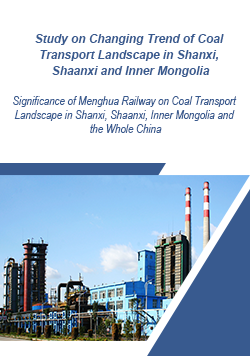
Date of completion: Jul, 2018
TOTAL: US$ 5000
Online Self-purchase
Part One China Current Coal Transport Landscape in Shanxi, Shaanxi and Inner Mongolia
1. China Coal Supply & Demand Landscape
1.1 China coal resources distribution
1.2 China coal production
1.3 China coal consumption
2. China Coal Transport Volume and Inter-provincial Transfer
2.1 China total coal transport volume
2.2 Coal transports via railway
2.3 Coal transports via roadway
2.4 Coal transports via seaway and waterway
2.5 Inter-provincial coal inflows and outflows
3. Status Quo and Planning of Coal Transport Corridors in Shanxi, Shaanxi and Inner Mongolia
3.1 Status quo and planning of coal railway transport corridors
3.1.1 Main railway corridors for sending coal from western China to eastern China
Routes, capacities, transport volume, place of departure/destination and mileage of Northern, Middle and Southern Railway Corridors
3.1.2 Main railway corridors for sending coal from northern China to southern China
Routes, capacities, transport volume, place of departure/destination, mileage
3.1.3 Main under-construction and under-planning railway lines
3.2 Status quo and planning of coal roadway transport corridors: transport volume of major highways
3.3 Status quo and planning of coal seaway/waterway transport corridors:
3.3.1 Infrastructure of main transfer ports and coal throughput
3.3.2 Seaway transport landscape
3.3.3 Seaway-to-waterway transport landscape
Part Two Significance of Menghua Railway (Inner Mongolia-Jiangxi) on Coal Transport Landscape in Shanxi, Shaanxi, Inner Mongolia and the Whole China
4. Introduction to Menghua Railway
4.1 Basic information
4.1.1 Design mileage and transport capacity
4.1.2 Main stations and flow directions
4.1.3 Railway investment and sources of funding
4.2 Construction progress
4.2.1 Construction progress
4.2.2 Projected commissioning time and transport capacity
4.3 Positioning and strategic significance of Menghua Railway
5. Coal Sources Analysis of Passing Areas of Menghua Railway
Analyzing coal sources from such three main outflow regions as Shanxi, Shaanxi and Inner Mongolia
5.1 Passing areas ofMenghua Railway through Shanxi, Shaanxi and Inner Mongolia and coal origins
5.2 Coal resources/reserve in Shanxi, Shaanxi and Inner Mongolia
5.3 Coal supply & demand analysis and forecast (output and consumption) in Shanxi, Shaanxi and Inner Mongolia
5.4 Coal transports in Shanxi, Shaanxi and Inner Mongolia
5.4.1 Coal outflows from Shanxi, Shaanxi and Inner Mongolia
5.4.2 Inter-provincial coal inflows and outflows
5.4.3 Coal outflows via different transport modes
6. Coal Inflow Provinces via Menghua Railway
Hubei, Hunan and Jiangxi are the three main coal inflow provinces via Menghua Railway. We will analyze coal markets in such three provinces and forecast the coal inflow demands over 2018 to 2025
6.1 Coal resources/reserve
6.2 Coal production capacity and output
6.3 Coal supply & demand analysis and forecast (2018-2025 coal output and consumption forecast)
6.4 Main coal sources and transport modes in coal consumption areas
6.5 2018-2025 coal inflows forecast into coal consumption areas
7. Significance of Menghua Railway on China Domestic Coal Transport Landscape
7.1 China coal transport volume forecast
7.1.1 2018-2025 China coal supply & demand forecast
7.1.2 2018-2025 China coal transport capacity and volume forecast
——Railway transport capacity and volume
——Roadway transport capacity and volume
——Seaway/waterway transport capacity and volume ( Ports in northern China / Seaway-to-waterway ports )
7.2 2018-2025 coal outflows forecast fromShanxi, Shaanxi and Inner Mongolia
7.2.1 Total outflows
7.2.2 Outflows via railway
7.2.3 Outflows via roadway
7.2.4 Outflows via waterway
7.3 Significance of Menghua Railway on China domestic transport landscape
7.3.1 Influences on flow directions and volumes of coals from Inner Mongolia and Shaanxi
7.3.2 Influences on waterborne and seaway-to-waterway coal transports
7.3.3 Influences on trucking transports
8. Economical Assessment on coal transport of Menghua Railway
8.1 Railway freight analysis and forecast from Shanxi, Shaanxi, Inner Mongolia and Henan to China northern ports
8.2 Ocean freight analysis and forecast from China northern ports to China southern ports
8.3 Waterway freight analysis and forecast from seaway-to-waterway ports to Hunan, Hubei and Jiangxi
8.4 Direct railway freight analysis and forecast fromShanxi, Shaanxi, Inner Mongolia and Henan toHunan, Hubei and Jiangxi
8.5 Freight forecast from Shanxi, Shaanxi, Inner Mongolia and Henan directly to Hunan, Hubei and Jiangxi via Menghua Railway
8.6 Comparison & conclusions of economical efficiency of Menghua Railway
9. Overall Advantage of Menghua Railway
9.1 Coal resources at origins
9.2 Coal transport capacity
9.3 Coal supply assurance
9.4 Coal transport costs
9.5 Mitigating railway transport pressure for sending coal from western China to eastern consumption provinces
Hot-sale Products